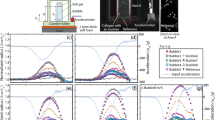Abstract
Various static and (equilibrium and non-equilibrium) dynamic molecular-level computational methods and tools are utilized in order to investigate the basic shock-wave physics and shock-wave material interactions in polyurea (a nano-phase segregated elastomeric co-polymer). The main goal of this investigation was to establish relationships between the nano-segregated polyurea microstructure (consisting of rod-shaped, discrete, so-called “hard domains” embedded into a highly compliant, so-called soft matrix) and the experimentally established superior capability of this material to disperse and attenuate resident shock waves (e.g., those generated as a result of blast-wave impact). By analyzing molecular-level interactions of the shock waves with polyurea, an attempt was made to identify and quantify main phenomena and viscous/inelastic deformation and microstructure-altering processes taking place at the shock front, which are most likely responsible for the superior shock-mitigation behavior of polyurea. Direct molecular-level simulations of shock-wave generation and propagation in the “strong-shock” regime are utilized in order to construct the appropriate shock-Hugoniot relations (relations which are used in the construction of the associated continuum-level material models). Extension of these relations into the “weak-shock” regime of interest from the traumatic brain injury prevention point of view is also discussed.












Similar content being viewed by others
References
Grujicic M, He T, Pandurangan B (2011) Multidiscip Model Mater Struct 7(2):96
Grujicic M, Bell WC, Pandurangan B, He T (2010) Mater Des 31:4050
Grujicic M, Arakere A, Pandurangan B, Grujicic A, Littlestone AA, Barsoum RS (2012) Multidiscip Model Mater Struct 8(2)
Grujicic M, He T, Pandurangan B, Svingala FR, Settles GS, Hargather MJ (2011) J Mater Eng Perform 21(1):2
Grujicic M, Pandurangan B, King AE, Runt J, Tarter J, Dillon G (2011) J Mater Sci 46(6):1767. doi:10.1007/s10853-010-4998-y
Bogoslovov RB, Roland CM, Gamache RM (2007) Appl Phys Lett 90:221910
Grujicic M, Pandurangan B, He T, Cheeseman BA, Yen C-F, Randow CL (2010) Mater Sci Eng, A 527(29–30):7741
Grujicic M, Bell WC, Pandurangan B, Glomski PS (2011) J Mater Eng Perform 20(6):877
Grujicic A, LaBerge M, Grujicic M, Pandurangan B, Runt J, Tarter J, Dillon G (2011) J Mater Eng Perform. doi:10.1007/s11665-011-0065-3
Choi T, Fragiadakis D, Roland CM, Runt J (2012) Macromolecules 45:3581
Qiao J, Amirkhizi AV, Schaaf K, Nemat-Nasser S, Wu G (2011) Mech Mater 43:598
Grujicic M, Pandurangan B, Bell WC, Cheeseman BA, Yen C-F, Randow CL (2011) Mater Sci Eng, A 528(10–11):3799
Davison L (2008) Fundamentals of shock wave propagation in solids. Springer, Berlin
Grujicic M, Pandurangan B, Bell WC, Cheeseman BA, Patel P, Gazonas GA (2011) J Mater Sci 46(22):7298. doi:10.1007/s10853-011-5691-5
Arman B, Reddy AS, Arya G (2012) Macromolecules 45:3247
http://www.accelrys.com/mstudio/msmodeling/visualiser.html. Accessed 2 June 2012
Runt J (2012) Work in progress, Pennsylvania State University, University Park, PA
http://www.accelrys.com/mstudio/msmodeling/amorphouscell.html. Accessed 2 June 2012
Sun H (1998) J Phys Chem B 102:7338
Grujicic M, Cao G, Gersten B (2004) Mater Sci Eng B 107:204–216
Grujicic M, Sun YP, Koudela KL (2009) Appl Surf Sci 253:2007
http://www.accelrys.com/mstudio/msmodeling/discover.html. Accessed 2 June 2012
Theodorou DN, Suter UW (1986) Macromolecules 19:139
Amirkhizi AV, Isaacs J, McGee J, Namet-Nasser S (2006) Phil Mag 86(36):5847
Mock W, Bartyczak S, Lee G, Fedderly J, Jordan K (2009) In: Shock compression of condensed matter. American Institute for Physics, Melville, NY, p 1241–1244
Grujicic M, Bell WC, Pandurangan B, Cheeseman BA, Patel P, Gazonas GA (2012) J Mater Des 35:144
Grujicic M, Pandurangan B, Qiao R, Cheeseman BA, Roy WN, Skaggs RR, Gupta R (2008) Soil Dyn Earthquake Eng 28:20
Grujicic M, Pandurangan B, Zecevic U, Koudela KL, Cheeseman BA (2007) Multidiscip Model Mater Struct 3:287–312
Holian BL, Straub GK (1979) Phys Rev Lett 43:1598
Holian BL, Hoover WG, Moran B, Straub GK (1980) Phys Rev A 22:2498
Castagna AM, Choi T, Dillon GP, Runt J (2012) Macromolecules (submitted for publication)
Acknowledgements
The material presented in this paper is based on work supported by the Office of Naval Research (ONR) research contract entitled “Elastomeric Polymer-By-Design to Protect the Warfighter Against Traumatic Brain Injury by Diverting the Blast Induced Shock Waves from the Head”, Contract Number 4036-CU-ONR-1125 as funded through the Pennsylvania State University, the Army Research Office (ARO) research contract entitled “Multilength Scale Material Model Development for Armor-grade Composites”, Contract Number W911NF-09-1-0513, and the Army Research Laboratory (ARL) research contract entitled “Computational Analysis and Modeling of Various Phenomena Accompanying Detonation Explosives Shallow-Buried in Soil” Contract Number W911NF-06-2-0042. The authors are indebted to Drs. Roshdy Barsoum of ONR and Larry C. Russell, Jr. of ARO for their continuing support and interest in this study.
Author information
Authors and Affiliations
Corresponding author
Rights and permissions
About this article
Cite this article
Grujicic, M., Yavari, R., Snipes, J.S. et al. Molecular-level computational investigation of shock-wave mitigation capability of polyurea. J Mater Sci 47, 8197–8215 (2012). https://doi.org/10.1007/s10853-012-6716-4
Received:
Accepted:
Published:
Issue Date:
DOI: https://doi.org/10.1007/s10853-012-6716-4




